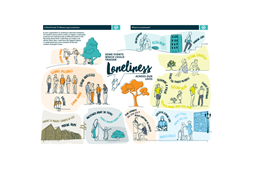Triggers for loneliness across the life course
The evidence suggests that a mixture of personal characteristics and circumstances, life events and transitions and wider structural and societal factors can increase the likelihood of loneliness. These are outlined below:
Personal characteristics and circumstances
- Age – younger adults aged 16 to 24 and older adults aged 75 and over are most likely to report loneliness
- Ethnicity and language – some older people from black, Asian and minority ethnic groups report higher levels of loneliness than their white British counterparts
- Living arrangements and marital status – those who live alone and/or are divorced are more likely to be lonely
- Geography – some studies suggest loneliness is higher in rural than urban areas, but high levels are found in deprived urban areas
- Housing – people living in residential care are lonelier than those living in the community
- Health and disability status – those reporting poor mental or physical health, and disabled people are more likely to be lonely
- Poverty – people on low incomes, those who are unemployed (and seeking work) are more likely to report loneliness “often/always” than those in employment or self-employment.
- Psychological characteristics and responses – our loneliness levels are linked to how we understand, make sense of, and respond to social situations, and to our own attitudes towards ourselves and to ageing
- Providing informal care – carers are more likely to experience loneliness
- Sexual orientation – studies show high levels of loneliness among older lesbian, gay and bisexual people
Profiles of people who are more likely to experience loneliness include:
- Widowed older homeowners living alone with long-term health conditions.
- Unmarried, middle-agers with long-term health conditions.
- Younger renters with little trust and sense of belonging to their area.
Life events and transitions
Common life events and transitions can be triggers for loneliness too.
Bereavement is one of the principle risk factors for loneliness. The loss of a partner, family member, friend or network through death can evoke a range of distressing emotions and life changes including living alone and reduced social connections.
Expectations of what ‘life should look like’ when going through particular transitions can make loneliness worse (by intensifying the mismatch between someone’s desired level of social connection and their reality).
Structural and societal factors
The infrastructure and attitudes in our society can increase or intensify loneliness.
- Transport
There is good evidence of the importance of transport in keeping people socially connected. It is important the transport is accessible, appropriate and affordable.
- The built environment
People needed places and spaces in which to connect in their communities, and the quality of the design and the accessibility of the built environment can either enable or disable people in connecting with one another.
A lack of facilities and spaces (eg benches, parks and green space, public toilets, adequate lighting, well-kept pavements) can both limit opportunities for socialising and outdoor recreation which help to foster a sense of neighbourliness and deter people from making use of the public spaces available.
- Digital technology
There is a consensus that connecting online should not be a substitute for face-to-face contact. The increasing use of technology has both pros and cons.
It can enable people to maintain and deepen connections and bring people together around shared interests and identities.
Digital technology can also exacerbate exclusion, particularly among older people who remain less likely to be online. Social media content can create unrealistic expectations for relationships, connections and lifestyles among young people.
- Societal and cultural norms and attitudes
- Stigma around loneliness: loneliness is perceived as embarrassing or somehow your own fault.
- A tradition of ‘stiff upper lip’, particularly amongst the older generation, who may prefer not to ‘open up’ and talk about their emotions and problems.
- Ageism – both the internal and societal belief that loneliness is an expected part of growing older.
- Stranger danger: the perceived inappropriateness of talking with strangers.

